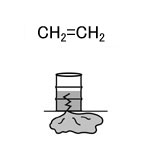| Case Name |
Leakage of high-pressure ethylene gas from gland packing of an acetone injection valve at a low-density polyethylene manufacturing plant |
| Pictograph |

|
| Date |
April 25, 1999 |
| Place |
Kawasaki, Kanagawa, Japan |
| Location |
Chemical factory |
| Overview |
An operator intended to open the valve, because acetone was to be injected into the suction side piping of the secondary booster compressor of a low density polyethylene plant (another name is high-pressure polyethylene). A lock bolt that fixed the valve handle and stem had become loose, and the handle was idling. The operator directly grasped the stem with a pipe wrench, and opened the valve. Excessive force was applied to the gland nut of the valve, the gland nut came off, and ethylene gas spouted out. |
| Incident |
At a low-density polyethylene manufacturing plant, an operator was opening an acetone injection valve connected to the suction side of the secondary booster compressor. At that time, ethylene gas with vinyl acetate spouted out through the valve gland packing. The operator received a slight injury to the face. Refer to Fig2. |
| Processing |
Manufacture |
| Individual Process |
Feed and charge |
| Process Flow |
Fig3.Unit process flow
|
| Substance |
Ethylene, Fig4 |
| Type of Accident |
Leakage |
| Sequence |
At about 14:00 on April 25, 1999, an operator was ordered to open the acetone injection line, and he tried to open the injection valve. However, the valve idled.
At 14:18, as the handle idled, he grasped the stem of the valve with a pipe wrench. Suddenly high-pressure ethylene gas (1.35 MPaG) with vinyl acetate spouted out through the valve gland packing. He was injured on the face.
At 14:19, the injured operator rushed to the control room, and an emergency shutdown was executed.
At 14:20, the spouting stopped.
Stem (of the valve): The shaft which moves the inner valve up and down. A handle to rotate the stem is attached at the upper part. |
| Cause |
The operator turned the valve by grasping the valve stem with a pipe wrench directly, because the valve handle had idled. Therefore, the gland nut of the valve came off, and ethylene gas spouted out. The cause of idling is that a hexagonal lock bolt which fixes the handle and the stem had become loose. A hexagonal nut that tightened the lock bolt was not found, so the operator intended to open the valve directly using the pipe wrench, because the time for the work was approaching. |
| Response |
The spread of damage was prevented by shutting down the plant. |
| Countermeasures |
1. The place of the hexagonal nut for the valve handle was clearly displayed.
2. The thickness of the gland nut stopper was changed from 0.8 mm to 2.0 mm.
3. The handle of the valve was changed to a round shape from a cylinder shape.
4. The prohibition of using tools for valve operation was made known to operators thoroughly.
5. Re-training was carried out for operators on structure and handling of the valve.
6. Work standards and management criteria were reviewed. |
| Knowledge Comment |
An accident may occur when a problem is left unattended. It is important to take preventative measures for an accident. |
| Background |
1. The valve handle was the type that readily idled. The idled valve handle was cylindrical, but a round handle is more suitable.
2. There was a judgment error. As the time for acetone injection approached, the operator had to judge hurriedly whether acetone injection should be immediately started using the pipe wrench in awareness of the danger, or whether he should start acetone injection safely after the lock bolt was tightened. He selected the method using the pipe wrench.
Indirectly, the following two points are considered.
3. There was a problem in the judgment criterion or in the operation manual. It was known that the valve was likely to idle, so the countermeasures for that situation should have been prepared. For example, operators should re-tighten the lock bolt without using a pipe wrench, though the time for work was pressing.
4. In addition, there was not a hexagonal nut to tighten the lock bolt at the side of the valve. It showed that there was insufficient field management.
3 and 4 above should not be regarded as mere human error. There is some problems to be regarded from a managerial viewpoint. |
| Incidental Discussion |
"It is forbidden to use tools for turning a valve handle except special tools in proportion to the size of the valve with a small diameter" is common sense among valve users. However, sometimes a valve handle is destroyed by using a pipe wrench and an extension pipe. Is there a better method than education? |
| Reason for Adding to DB |
Example of improper handling of a small valve |
| Scenario |
| Primary Scenario
|
Organizational Problems, Poor Management, Slackness of Management, Carelessness, Insufficient Understanding, Inadequate Risk Recognition, Planning and Design, Poor Planning, Poor Design, Malicious Act, Rule Violation, Safety Rule Violation, Failure, Fracture/Damage, Valve Failure and Leakage, Bodily Harm, Injury, 1 person injured
|
|
| Sources |
Kawasaki City. Fire fighting station, Prevention division, Peace section. Ethylene gas leak accident from the injection valve. Material of the Kawasaki City complex safety countermeasure committee (1999)
|
| Number of Injuries |
1 |
| Physical Damage |
106 kg of ethylene and 28 L of vinyl acetate spouted out. |
| Financial Cost |
¥51,000. (Material of the Kawasaki City Complex safety countermeasure committee) |
| Multimedia Files |
Fig2.Spouting situation figure
|
|
Fig4.Chemical formula
|
| Field |
Chemicals and Plants
|
| Author |
KOBAYASHI, Mitsuo (Office K)
TAMURA, Masamitsu (Center for Risk Management and Safety Sciences, Yokohama National University)
|
|